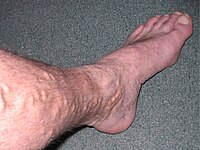
Photo from wikipedia
In the recent interview with Dr. Domingos Souza, published on the Journal’s blog, initial observations that lead to the introduction of the no-touch (NT) saphenous vein graft (SVG) harvesting technique… Click to show full abstract
In the recent interview with Dr. Domingos Souza, published on the Journal’s blog, initial observations that lead to the introduction of the no-touch (NT) saphenous vein graft (SVG) harvesting technique for coronary artery bypass grafting (CABG) were discussed. Quoting Albert Einstein (“imagination is more important than knowledge”), Souza admits that his 1989 observations during CABG surgery lead to the advent of the NT technique. He observed that during conventional (CON) SVG harvesting, venospasm occurs exactly when the perivascular tissue is removed, hence the idea of keeping the perivascular tissue intact was born. While arterial grafts are generally harvested with the outer pedicle intact, the SVG, when prepared as described by Favaloro, is harvested with the outer pedicle removed. Here, the trauma inflicted to the saphenous vein causes considerable vascular damage, which has a pronounced effect on graft patency. When using the NT technique, the SVG is harvested with minimal trauma and with the outer fat pedicle intact (Figure 1). This procedure not only minimizes vascular damage but also obviates the need for high pressure intraluminal saline distension, which is often used to overcome venospasm. Since the introduction of NT harvesting, a number of follow-up studies have been performed with NT SVGs, showing a marked improvement in graft patency when compared with CON SVGs at 16 years. Bypass surgery remains the most common cardiac procedure and demonstrates a survival benefit over percutaneous coronary intervention for complex and left main coronary artery disease. The CABG success is largely based on the long-term patency rate of bypass grafts. Improved long-term results are associated
Journal Title: Brazilian Journal of Cardiovascular Surgery
Year Published: 2020
Link to full text (if available)
Share on Social Media: Sign Up to like & get
recommendations!